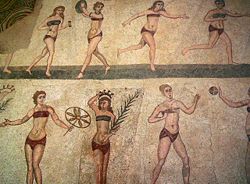 Female athletes wearing a bikini-like combination of a subligaculum and a very strophium (breast-cloth) (Sicily, c. 300 AD) | |
| Type | Undergarment |
|---|---|
A subligaculum was a kind of underwear worn by ancient Romans. It could come either in the form of a pair of shorts, or in the form of a simple loincloth wrapped around the lower body. It could be worn both by men and women. In particular, it was part of the dress of gladiators, athletes, and actors on the stage. [1] Leather subligacula have been found in excavations of 1st century Roman London. [2]


